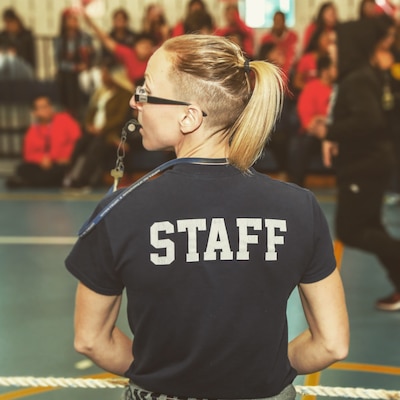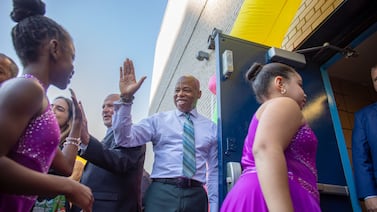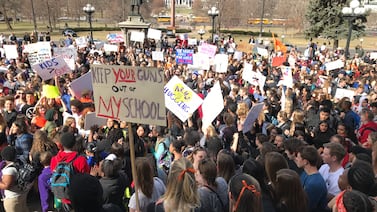Sign up for Chalkbeat’s free weekly newsletter to keep up with how education is changing across the U.S.
Ask just about any American 30 or older about the Presidential Fitness Test, and they are likely to have feelings. A lot of feelings.
Pride among the top performers, who managed to make pull-ups look easy; determination among those in the middle of the pack, as they huffed and puffed their way to a 10-minute mile; and, for many, embarrassment or worse because they could not sustain a flexed-arm hang or reach past their toes in a seated position. Students with disabilities were often left out altogether.
Now, those with memories of taking the Presidential Fitness Test have a new reason to share them: President Donald Trump said he is bringing the test back.
In reviving the test through a July 31 executive order, Trump invoked America’s upcoming 250th anniversary and the Make America Healthy Again Commission, chaired by U.S. Secretary of Health and Human Services Robert F. Kennedy Jr. The president’s order said declining health hurts national morale and military readiness, and the order establishes a council to devise new versions of the Presidential Fitness Test and the Presidential Fitness Award for exemplary achievement.
A precursor to the Presidential Fitness Test was developed during the Eisenhower administration to ensure that young people were in fighting shape during the Cold War. An early version of the test included a softball throw that mimicked the motion of throwing a grenade.
Shortly before his inauguration, President John F. Kennedy unleashed something of a moral panic when, arguing in Sports Illustrated for national fitness standards, he wrote that American “softness” was tantamount to a national security threat. Trump cited that article in his executive order.
The test and award were phased out during the Obama administration in favor of a more inclusive and holistic program that stressed healthy fitness zones and personal goal-setting. It commonly included the PACER test, an aerobic capacity drill that involves running 20-meter laps at an increasingly fast pace.
Chalkbeat asked three public school P.E. teachers to share their thoughts on the likely return of the Presidential Fitness Test, what should be on it now, and the pros and cons of turning fitness testing into a national competition.
The teachers’ responses have been edited for length and clarity.
Tom Filline, who teaches P.E. to elementary school students in Melrose Park, Illinois, said returning to the Presidential Fitness Test is “a step backward” from the current iteration. Felline, known as The Angry Gym Teacher on TikTok, said he prefers the PACER test to the timed mile, which he struggled with as a kid.
In middle school, we did the mile run, and that’s what I have the most vivid memories of. I was always one of the last, if not the last. I think I ran a 12- or 13-minute mile in middle school. It was humiliating. It’s hard to build up your own confidence when you’re just thinking about that spotlight on you.
If students are constantly being pitted against each other and told they need to get strong so they can fight in a war someday, then what they are going to remember is the trauma, the pressure, the intensity of the moment, instead of, “I scored 20 laps on the PACER test last year, and this year I was able to get 25 or 30 laps.”
These days, kids go through a ton of standardized tests in the classroom, and imagine what it would be like if everyone could see each other’s reading and math scores. It would be a nightmare, and that’s how it is with fitness testing, so you have to be extra sensitive. The Presidential Fitness Test was not sensitive. It was more like a bootcamp experience.
It doesn’t surprise me that this is the approach the Trump administration is taking. Almost every policy decision they’ve made is based on “we need to toughen up.” The message it sends to individual boys and girls is, “you’re not good enough, you’re not strong enough,” when the focus should be on teaching kids to intrinsically value having a good level of fitness so they can live a long life and dream big and do whatever they want to do.
Even when presidents go after education, they usually leave us P.E. teachers alone. Now it’s come for me, and I’m in the position of having to defend the future generation against this whole macho B.S.
Gilbert Schuerch teaches high school P.E. in Harlem. Schuerch, who writes the Substack Fit to Teach, said he’s not convinced that reinstating the Presidential Fitness Test will curb America’s obesity epidemic, but if it “sheds a bit more spotlight on kids working hard on their fitness, I’m not opposed to it.”
It would not surprise me if this administration was looking to create this as a massive national competition again, and there are pluses and minuses to that.

If you’re celebrating a kid who runs the fastest mile, that’s great. We recognize valedictorians and salutatorians in our schools all the time. You just have to acknowledge that this kid isn’t any better or more worthy than anybody else because of that. It’s your job as a teacher to emphasize, “Hey, did you improve?” That’s a huge deal, too.
I think people have such a visceral reaction to the Presidential Fitness Test because it may have been their first true introduction to pain. It’s not like failing a math test, where you’re sitting there helplessly and just don’t know what to do. This test is the opposite. You know exactly what to do, and your body is showing you why you may not be able to run as fast as you’d like to.
Maybe you do a pretest. Have them run half a mile, time it, and double it, and that’s their pre-score for the mile. Then you prepare for a month, and see if you can beat your time. And then, even if you’re in the bottom 50% but you improved on your test from a month ago, you can say, “You guys trained, you had a biological response to it, and you improved.” Much like any learning.
If I was going to design the Presidential Fitness Test [for my students], I think the PACER test is a great test. I also think it’s important for kids to learn how to move their body in a really safe way to pick up some weights. There would be some basic standards, like you’re healthy if you can lift your body weight off the ground in a trap bar deadlift. And then on test day, you celebrate the kids who can lift double, triple their body weight, because those are incredible feats of strength. That’s cool stuff.
Alicia Mannino will begin teaching at a K-8 school in Philadelphia this fall, marking her 16th year as a P.E. instructor. She worries that reinstating the Presidential Fitness Test will mean a return to a “one size fits all approach” to fitness that doesn’t work for everyone and could leave students feeling discouraged.
Over my whole career, I never had a coworker be like, “We’ve got to do the Presidential Fitness Test.” I don’t really know any gym teacher that thinks that’s a good idea.
I do kind of make my own fitness test, with push-ups and sit-ups. I work on different varieties of these exercises. There are wider push-ups. There are CrossFit push-ups — it’s not just one size fits all. I don’t like any of the mile runs because some people are born runners, and some people just aren’t. I do the [PACER] beep test, which is also not the best, but these tests don’t count for any type of grade.

I love putting music on for them to relate to, that’s appropriate for them to dance to. If they’re breaking a sweat and doing the right things with the activity or game we’re doing, who am I to say what anyone else’s fitness is like? I like to lift weights. Some people like to dance. Some people like to walk. Gym is supposed to be that place where you go, you have fun, you let loose. So, standardizing a fitness test — we’re setting ourselves up for failure. I think it’s a publicity stunt, honestly.
It’s literally drawing out the athletes, and it’s going to create a line of who can do this the most, who can do it the best, and who can do it the worst. It’s just going to lead to bullying, to body dysmorphia, to low self-esteem.
You tell kids not to bring their phones to class, but they sneak them in no matter what. People take pictures if a kid wears the wrong thing. Now, imagine, on top of everything else, you have someone taking pictures of people in their gym uniforms, on the track, sweating and feeling vulnerable.
Gabrielle Birkner is Chalkbeat’s features editor and fellowship director. Email her at gbirkner@chalkbeat.org.







